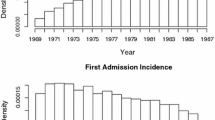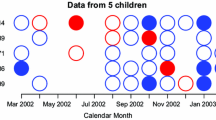Abstract
Recurrent events are of interest in many research fields. The analysis of past developments of processes through dynamic covariates is useful to understand the present and future of processes generating recurrent events. In this paper, we consider modelling and estimation of effects of number of prior events and carryover effects on the evolution of recurrent event processes through dynamic models for event counts. These process features are related to monotonic trends in gap times and clustering of events together over time in recurrent event processes, and are frequently seen in biomedical and epidemiology studies involving recurrent events. Insights about the impacts of these features may provide opportunities for treatment improvements and to develop prevention strategies. We discuss issues in the parametric maximum likelihood estimation of these features through multiplicative recurrent event models for event counts. We extend our discussion to the settings in which excess variation in the rate of event occurrences across multiple individuals is present. We illustrate our methods to analyse a dataset from an asthma study involving children.



Similar content being viewed by others
Data Availability
All computations were performed in statistical computing software R. The computer code used to obtain all results and to generate the simulated data is available from authors upon request. In the data application, publicly available data were analysed. The authors confirm that they do not have any special access privileges to these data.
References
Cox DR, Lewis PAW (1966) The statistical analysis of series of events. Chapman and Hall, London
Cook RJ, Lawless JF (2007) The statistical analysis of recurrent events. Springer, New York
Aalen OO, Borgan O, Gjessing HK (2008) Survival and event history analysis: a process point of view. Springer, New York
Peña EA, Hollander M (2004) Models for recurrent events in reliability and survival analysis. Springer, Boston, pp 105–123
Peña EA (2006) Dynamic modeling and statistical analysis of event times. Stat Sci 21(4):1–26. https://doi.org/10.1214/088342306000000349
Kalbfleisch JD, Prentice RL (2002) The statistical analysis of failure time data, 2nd edn. John Wiley and Sons, New York
Lin DY, Wei LJ, Yang I, Ying Z (2000) Semiparametric regression for the mean and rate functions of recurrent events. J R Stat Soc: Ser B (Stat Methodol) 62(4):711–730. https://doi.org/10.1111/1467-9868.00259
Lawless JF, Cigsar C, Cook RJ (2012) Testing for monotone trend in recurrent event processes. Technometrics 54(2):147–158. https://doi.org/10.1080/00401706.2012.676944
Kvist K, Andersen PK, Angst J, Kessing LV (2008) Repeated events and total time on test. Stat Med 27(19):3817–3832. https://doi.org/10.1002/sim.3270
Cook RJ, Lawless JF (2013) Concepts and tests for trend in recurrent event processes. J Iran Stat Soc 12(1):35–69
Post RM (1992) Transduction of psychosocial stress into the neurobiology of recurrent affective disorder. Am J Psychiatry 149(8):999–1010. https://doi.org/10.1176/ajp.149.8.999
Kessing LV, Olsen EW, Andersen PK (1999) Recurrence in affective disorder: analyses with frailty models. Am J Epidemiol 149(5):404–411. https://doi.org/10.1093/oxfordjournals.aje.a009827
Farrington CP, Whitaker HJ (2006) Semiparametric analysis of case series data. J R Stat Soc: Ser C (Appl Stat) 55(5):553–594. https://doi.org/10.1111/j.1467-9876.2006.00554.x
Whitaker HJ, Paddy FC, Spiessens B, Musonda P (2006) Tutorial in biostatistics: the self-controlled case series method. Stat Med 25(10):1768–1797. https://doi.org/10.1002/sim.2302
Cigsar C, Lawless JF (2012) Assessing transient carryover effects in recurrent event processes with application to chronic health conditions. Ann Appl Stat 6(4):1641–1663. https://doi.org/10.1214/12-AOAS560
Farrington P, Whitaker H, Weldeselassie YG (2018) Self-controlled case series studies: a modelling guide with R. Chapman and Hall/CRC
Brown M, Proschan F (1983) Imperfect repair. J Appl Prob 20(4):851–859. https://doi.org/10.2307/3213596
Baker RD (2001) Data-based modeling of the failure rate of repairable equipment. Lifetime Data Anal 7:65–83. https://doi.org/10.1023/A:1009677227030
Picado C (1996) Classification of severe asthma exacerbations: a proposal. Eur Respir J 9(9):1775–1778
Chernyavsky IL, Croisier H, Chapman LA, Kimpton LS, Hiorns JE, Brook BS, Jensen OE, Billington CK, Hall IP, Johnson SR (2014) The role of inflammation resolution speed in airway smooth muscle mass accumulation in asthma: insight from a theoretical model. PLoS ONE 9(3):e90162
Brightling C, Gupta S, Gonem S, Siddiqui S (2012) Lung damage and airway remodelling in severe asthma. Clin Exp Allergy 42(5):638–649
Grandell J (1997) Mixed poisson processes, vol 77. CRC Press
Cox DR, Isham V (1980) Point processes, vol 12. CRC Press
Cox DR (1972) The statistical analysis of dependencies in point processes. In: Lewis PAW (ed) Stochastic point processes. Wiley, New York, pp 161–175
Lawless JF, Thiagarajah K (1996) A point-process model incorporating renewals and time trends, with application to repairable systems. Technometrics 38(2):131–138. https://doi.org/10.1080/00401706.1996.10484458
Xu S, Zhang L, Nelson JC, Zeng C, Mullooly J, McClure D, Glanz J (2011) Identifying optimal risk windows for self-controlled case series studies of vaccine safety. Stat Med 30(7):742–752. https://doi.org/10.1002/sim.4125
Xu S, Hambidge SJ, McClure DL, Daley MF, Glanz JM (2013) A scan statistic for identifying optimal risk windows in vaccine safety studies using self-controlled case series design. Stat Med 32(19):3290–3299. https://doi.org/10.1002/sim.5733
Neyman J, Scott EL (1972) Processes of clustering and applications. In: Lewis PAW (ed) Stochastic point processes. Wiley, New York, pp 646–681
Daley DJ, Vere-Jones D (2003) An introduction to the theory of point processes: volume I: elementary theory and methods. Springer, New York
Snyder DL, Miller MI (2012) Random point processes in time and space. Springer
Cox DR, Hinkley DV (1974) Theoretical statistics. Chapman and Hall/CRC, New York
Andersen PK, Borgan O, Gill RD, Keiding N (1993) Statistical models based on counting processes. Springer-Verlag, New York
Gjessing HK, Røysland K, Pena EA, Aalen OO (2010) Recurrent events and the exploding cox model. Lifetime Data Anal 16:525–546
Feller W (1968) An introduction to probability theory and its applications, vol 1, 3rd edn. Wiley, New York
Sandberg S, Paton JY, Ahola S, McCann DC, McGuinness D, Hillary CR, Oja H (2000) The role of acute and chronic stress in asthma attacks in children. Lancet 356(9234):982–987. https://doi.org/10.1016/S0140-6736(00)02715-X
Duchateau L, Janssen P, Kezic I, Fortpied C (2003) Evolution of recurrent asthma event rate over time in frailty models. J R Stat Soc: Ser C (Appl Stat) 52(3):355–363. https://doi.org/10.1111/1467-9876.00409
Akaike H (1974) A new look at the statistical model identification. IEEE Trans Autom Control 19(6):716–723. https://doi.org/10.1109/TAC.1974.1100705
Self SG, Liang KY (1987) Asymptotic properties of maximum likelihood estimators and likelihood ratio tests under nonstandard conditions. J Am Stat Assoc 82(398):605–610. https://doi.org/10.1080/01621459.1987.10478472
Dean C, Lawless JF (1989) Tests for detecting overdispersion in poisson regression models. J Am Stat Assoc 84(406):467–472. https://doi.org/10.1080/01621459.1989.10478792
Aalen OO, Fosen J, Weedon-Fekjær H, Borgan Ø, Husebye E (2004) Dynamic analysis of multivariate failure time data. Biometrics 60(3):764–773. https://doi.org/10.1111/j.0006-341X.2004.00227.x
Simpson SE (2013) A positive event dependence model for self-controlled case series with applications in postmarketing surveillance. Biometrics 69(1):128–136. https://doi.org/10.1111/j.1541-0420.2012.01795.x
Acknowledgements
We would like to thank anonymous reviewers for their helpful comments that improved the clarity of this paper.
Funding
This study was supported by the Natural Sciences and Engineering Research Council of Canada [RGPIN 2015-06152 (Candemir Cigsar)].
Author information
Authors and Affiliations
Corresponding author
Ethics declarations
Conflict of interest
The authors have no conflict of interest to declare that are relevant to the content of this article.
Supplementary Information
Below is the link to the electronic supplementary material.
Appendices
Appendix A Explosion of Dynamic Recurrent Event Processes
In this appendix, we present details and results of a simulation study conducted to investigate the issue of dishonest process \(\left\{ N_{i} (t);t\ge 0\right\}\) with the intensity function (3). For the data generation, we considered the intensity function (3) with \(\lambda _{0i} (t)\) fixed at a constant value \(\alpha\) \((\alpha =1)\) and without external covariates \(\varvec{x}_{i}(t)\). We generated data under 36 scenarios with various values of \(\gamma\), \(\beta\), \(\Delta\) and \(\tau\) as denoted in Table 9. With every combination of \(( \gamma , \beta , \Delta , \tau )\), we simulated 10000 realizations under four different models. The first model (Model 1 in Table 9) was the aforementioned dishonest process with the intensity function \(\lambda _{i}[t \, | \, \mathcal {H}_{i}(t)] = \exp \left[ \gamma \, N_{i}(t^{-}) + \beta \, Z_{i}(t) \right]\). We replaced the dynamic covariate \(N_{i}(t^-)\) with its trimmed version \(N_{i}^{*}(t^{-})\) given in (6) with cutoff points \(c=100,50\) and 20 in the second, third and fourth models (Models 2, 3, and 4 in Table 9), respectively, so that we were able to compare the results in an empirical setting. Note that \(c=\infty\) in Model 1, meaning that \(N_{i}^{*}(t^{-})=N_{i}(t^{-})\). In this empirical setting, we considered the process as exploded if it experienced 1000 events during its followup, and in this case, the simulation algorithm was stopped generating further events. Number of explosions and the maximum number of events in 10000 realizations for each scenario are reported in Table 9.
When \(\gamma =0\), processes in the first twelve scenarios in Table 9 did not explode for any value of \(\tau\). When \(\gamma >0\), the number of explosions increased as the followup time \(\tau\) increased. It is also noted that, when \(\gamma >0\), any increase in the value of \(\beta\) or carryover effects period \(\Delta\) also resulted in an increase in the number of explosions. However, when \(\gamma >0\), the number of explosions reduced as the cutoff value c decreased for any given (\(\gamma\), \(\beta\), \(\Delta\), \(\tau\)) combination. Some other suggestions, e.g. modifying \(N_{i}(t^-)\) with time t, to handle explosions due to \(N_{i}(t^-)\) are discussed by Aalen et al. [3, Section 8.6.3]. The coefficients of those modified versions of \(N_{i}(t^-)\) may not be easily interpretable. Therefore, we prefer to use \(N_{i}^*(t^{-})\) given in (6) to handle dishonest processes in most of the applications especially when the subjects do not experience too many events during their followups.
Appendix B Derivation of Marginal Intensity Function in Random Effects Model
Suppose that m independent continuous time counting processes are included in a study. Let \(\left\{ N_i(t),t\ge 0\right\}\), \(i=1\), 2, \(\ldots\), m, be the ith process with the intensity function \(\lambda _i\left[ t \, | \, \mathcal {H}_i(t)\right]\), where \(\mathcal {H}_i(t) = \left\{ N_i(s); 0 \le s<t\right\}\) is the history of the process. Our goal is to derive the marginal density function \(\lambda _i \left[ t \, | \, \mathcal {H}_i(t)\right]\) from the conditional intensity function \(\lambda _i\left[ t \, | \, \mathcal {H}_i(t),\nu _i\right]\), where the \(\nu _i\) are i.i.d. random effects from a gamma distribution with mean 1 and variance \(\phi\). To this end, we let \(\delta N_i(t)\) denote the number of events in \([t,t+\delta t)\) for the counting process \(\left\{ N_i(t),t\ge 0\right\}\). Then, as \(\delta t \rightarrow 0\),
where \(g(\nu _i)\) denotes the p.d.f. of the random effect \(\nu _i\), \(i=1\), 2, \(\ldots\), m, and any probability notation with \(\mathcal {H}_i(t)\) denotes the probability of observing a given sample path of the counting process \(\left\{ N_i(t),t\ge 0\right\}\) over [0, t) . Thus, if we let \(N_i(t^-) = n_i\), we observe \(n_i\) events over the interval [0, t) at times \(t_{i1}\), \(t_{i2}\), \(\ldots\), \(t_{in_{i}}\), where \(t_{i1}< t_{i2}< \cdots <t_{in_i}\). We next specify the conditional intensity function \(\lambda _i\left[ t \, | \, \mathcal {H}_i(t),\nu _i \right]\) as follows:
where \(\varvec{W^*}_{i}(t)\) is a \(q \times 1\) vector that is allowed to contain functions of t and the event history \(\mathcal {H}_i (t)\), as well as external covariates \(\varvec{x}_{i} (t)\) and \(\varvec{\psi }\) is a \(q \times 1\) vector of parameters. Let \({\eta }_i(t) = \exp [\varvec{\psi }^{\prime } \varvec{W^*}_i(t)]\). The integrand in the denominator of (B1) can be written as
After taking the integral of (B3) with respect to \(\nu _i\), the denominator of (B1) is given by
Similarly, from the result in (B3), the numerator of (B1) is equal to
From the results given in (B4) and (B5) the marginal intensity function for the process \(\left\{ N_i(t),t\ge 0\right\}\), \(i = 1,\ldots ,m\), is then given by
Rights and permissions
Springer Nature or its licensor (e.g. a society or other partner) holds exclusive rights to this article under a publishing agreement with the author(s) or other rightsholder(s); author self-archiving of the accepted manuscript version of this article is solely governed by the terms of such publishing agreement and applicable law.
About this article
Cite this article
Nirmalkanna, K., Cigsar, C. Analysis of Recurrent Event Processes with Dynamic Models for Event Counts. Stat Biosci (2024). https://doi.org/10.1007/s12561-024-09432-x
Received:
Revised:
Accepted:
Published:
DOI: https://doi.org/10.1007/s12561-024-09432-x




